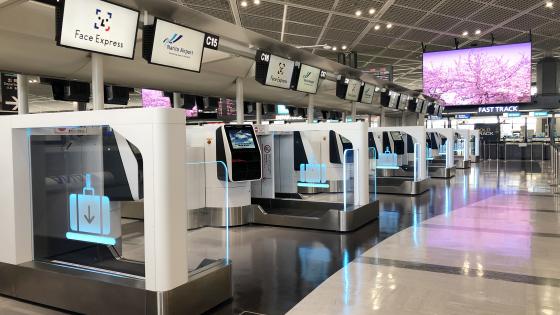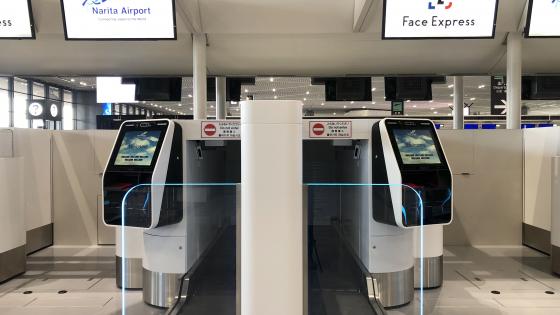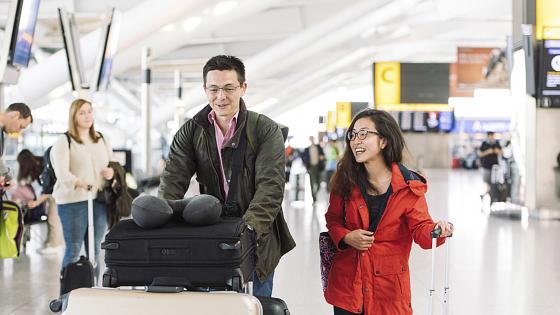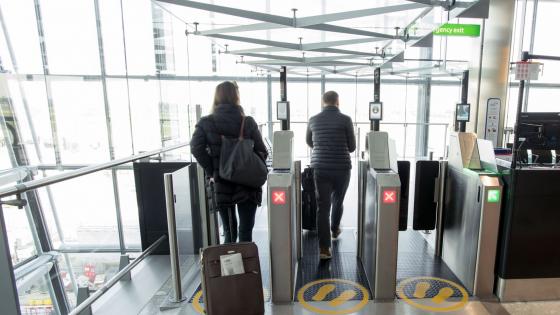Which airports are using facial recognition, and how? Mark Broadbent looks at the effectiveness of the technology and considers how soon we can expect a wide-scale roll-out
According to the 2022 International Air Transport Association (IATA) Passenger Survey, “biometrics in travel is here to stay”.
Amadeus biometrics can be found at Tokyo Narita Airport, while Thales’ Fly to Gate solution is in use at US and Asian airports, as well as European hubs, among them London/Heathrow Terminal 5. Collins Aerospace and Mitek are among other providers, the latter’s solutions in use throughout the US and Germany. US Customs and Border Protection and the Transportation Safety Agency are rolling out biometrics at checkpoints, gates, check-in and customs areas.
Airlines and airports are focused on delivering an easier, faster experience

Amadeus biometrics at Tokyo Narita Airport
Why biometrics?
Facial biometrics work by passengers using their mobile phone at home or via a kiosk at the airport to enable automatic identification in seconds.
Thales’ Fly to Gate product line manager Vincent Deveze said biometrics present “huge benefits in terms of speeding up and improving processing”. Holger Mattig, senior vice president, product management, Amadeus Airport and Airline Operations, said: “With demand for travel continuing to rebound, airlines and airports are focused on delivering an easier, faster experience that reduces queues and makes international travel more automated and enjoyable."

Bag drop is only one of many possible uses for biometrics
Mattig continued: “Consider how often a boarding pass is removed from the traveller's pocket during an average airport experience. Paper documents must be kept to hand for at least six separate interactions.
“Yet, with an end-to-end biometric deployment, it is possible for passengers to navigate the entire airport without needing to scan paper or mobile boarding passes. When approaching a check-in desk or bag drop unit, their face can become both their passport and their boarding pass, increasing speed and convenience while avoiding lengthy queues at checkpoints.”
Amadeus reports passengers spending less than 20 seconds at bag drop and, Mattig said, “40-60% fewer staff required for check-in and manual document checks” as a result of biometrics solutions.
He added: “Due to the integration with the departure control systems of airlines, any change to the journey, like seat or gate change, will be automatically processed and does not have to be manually handled as an exception by an agent.”
Deveze said biometrics processing “lightens the load of manual checking for airport and airline staff” and “provides greater flexibility [for]the airport floor and better passenger flow management”.
One size fits all
Rakan Khaled, Collins Aerospace general manager for airport solutions, said: “The beauty of our product is scalability, making it sufficient for small airports as well as large Tier One facilities. We collaborate with airports and airlines to get real-time feedback as to when they were thinking of deploying this type of technology in their environment. Our solutions also assist with airports that grow larger or smaller in volume and/or number of airlines.”
Amadeus’ Mattig described an end-to-end biometric process as “an ideal choice” for smaller airports, given staffing challenges and varying passenger flows, but he said: “Airports, regardless of size, can start small and scale up to new touchpoints at their own pace.”

Biometrics were introduced at London/Heathrow Terminal 5
Describing Thales’ Fly to Gate product as “a multi-tenant cloud-based solution to gradually accompany and accommodate any airports’ capacities”, Deveze noted: “It doesn’t require airport operators and airlines to deploy a full-scale infrastructure.”
He added: “Airports can start by offering biometric services at premium boarding gates, before expanding to a dedicated section within the airport and rolling out across a complete terminal. Fly to Gate can be integrated in any type of equipment (gated versus gateless), depending on airport layout and operations.”
Managing change
Mattig said: “It’s important to recognise biometrics represent a significant change and securing quick wins helps to build knowledge, increase familiarity among airlines, ground handlers and passengers [and] lower risk during implementation”.
He continued: “Boarding tends to represent the easiest stage of the passenger experience to implement, so we recommend airports start there. It only involves the identification of a single passenger and because an airline knows who is due to board that plane, the biometric matching process is also more straightforward. Starting small and proving the value is key.”
Mattig thinks airports should choose a flexible approach that minimises ongoing technical integration costs: “Ultimately, hundreds of cameras embedded at check-in, bag drop, security, the lounge and boarding will need to connect to the identity management platform [IMP] that match the passenger against their certified image.”
Protecting travellers’ data needs to be the highest priority for airports and airlines alike

The Fly to Gate back end provides passenger analytics to monitor operational performance
Collins Aerospace’s Khaled highlighted “change” as “a primary challenge” with introducing biometrics. Airside security agents, for example, are now not scanning a boarding pass or verifying a passport and/or visa, so they become part of the traveller’s customer experience and assist with customer requests and other enquiries. “It’s new and a different grasp for an agent but it can be beneficial in many scenarios,” Khaled said.
Chris Briggs, senior vice-president of identity at Mitek, agreed. He told Airports International: “A lot hinges on the travellers’ knowledge of using [this] technology. People who do not understand tech like e-Gates will reject the idea of it and opt to use manual passport checks. To secure full buy-in, it is also critical that airports invest more resources in explaining how everything works and assuring [travellers] regarding data privacy.”
Further potential
What are the next steps in developing biometrics at airports? Thales’ Deveze said: “We envision Fly to Gate to be rolled out on a global scale in the years to come, especially given the rise in air travellers necessitating further effective self-service solutions. We will soon announce projects in Asia. Fly to Gate can also integrate with immigration processes to ensure rigorous security. This will be another area we continue to expand in.”
Amadeus’ Mattig said: “Many airports are looking to increase non-aeronautical revenues and place a greater focus on retail and dining experiences. Biometrics could be introduced to offer passengers a quicker and more convenient way to pay for goods and services. The technology can also be used for wayfinding purposes in flight information display systems and at information kiosks.”
Collins’ Khaled said: “Biometrics not only focuses on the traveller/customer, but on the agent/ground handler working the flight from beginning to end. Biometrics is also involved while approaching the airport entrance along with being available on the entire airport property both outside and inside. From employee access control points to exit and entry, the sky is the limit.”

Facial recognition technology is designed to create a seamless passenger experience
Need to know more: Privacy as priority
Thales’ Vincent Deveze said: “The main challenge for airports when adopting biometrics is to ensure that travellers’ personal data is safe and secure, while building trust by reassuring them. Protecting travellers’ data needs to be the highest priority for airports and airlines alike.”
Deveze said: “Recent developments in data privacy legislation, particularly GDPR in the European Union, have been shaping data management approaches and pose important implementation considerations for global biometric initiatives and solutions.”
He continued: “All of Thales’ solutions are GDPR-compliant and designed with all the protection they require in terms of cybersecurity. Highly sensitive biometric data is processed in a secure manner using ultra-sophisticated encryption mechanisms.”
Personal information is protected by multiple layers of encryption and is transient in nature with a limited life span of a day maximum, Deveze said. Each passenger’s token is erased once the flight has taken off, so the airline doesn’t have passenger data unnecessarily stored on its database.
He added: “With data security an ongoing priority on consumers’ minds, it is essential for airports and airlines to build responsible biometrics into their solutions from the outset. The challenge from there is reassuring passengers on this matter, in order to truly bring them along on that digital transformation journey.”
